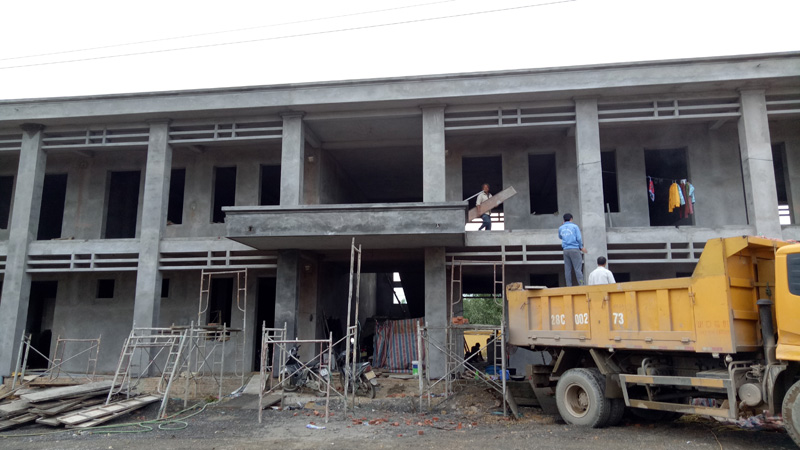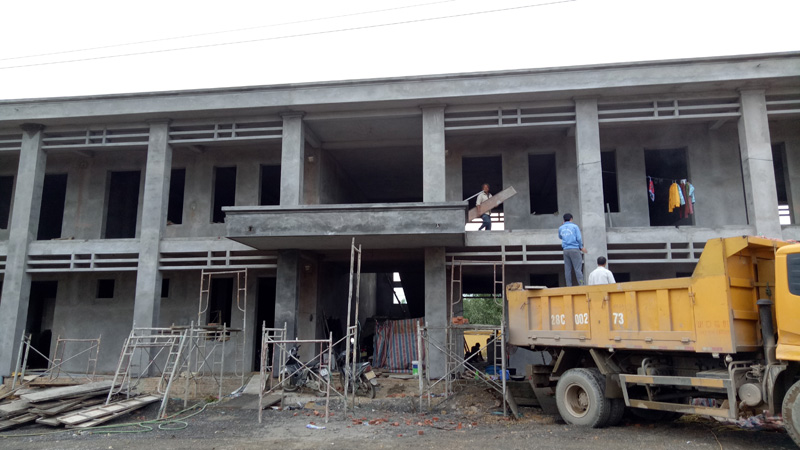
(HBO) - With the goal of becoming a new rural district in 2019, in the past years, Luong Son district has implemented synchronous solutions to concentrate capital resources. effectively integrate new rural development program into national target programs; strengthening the socialization, mobilizing resources from the people, enterprises, etc.

The project of nursery school in Tan Vinh
commune (Luong Son) was built up to meet the standard. Photo: DT.
Along with the efficient use of resources
from the state budget, Luong Son district promoted propaganda and mobilization
to mobilize socialization resources in the construction of new rural areas.
Propaganda has been implemented in various forms to help people understand
their meanings and roles. In addition, the district implemented well the
grassroots democracy regulations with the motto "People know, people
discuss, people do, people check", ensure the publicity, transparency of
receipts, payment, final settlement of the programs. At the same time, it
implemented well the emulation and reward work, praise and timely encouragement
of advanced typical collectives and individuals, good models or ways of
mobilizing people to participate in building new rural area. As a result, local
people, organizations and enterprises in the area have actively participated,
supported and contributed to the construction of new rural areas in various
forms such as contributing funds, supporting working days, land donation, etc.
From 2011 to 2017, Luong Son district
mobilized more than 1,500 billion VND to build new rural areas. In particular,
the local people contributed over 180 billion VND, donated more than 100
thousand m2 of land of all kinds, supported hundreds of thousands of working
days, etc. From these resources, the district has invested in building hundreds
of essential infrastructure facilities and supporting production development.
Thanks to the good mobilization of resources,
over the past 7 years, the program of building new rural areas in Luong Son
district has achieved positive results. Up to now, the district has 10/19
communes meeting new rural areas’ standards; averagely reaching 16.47 criteria
/ commune; the rural face of the district has many innovations. 100% communes
have been planned and managed according to new rural area plan. 100% of
inter-communal roads, inter-village roads, basic intra-field traffic are
hardened. The material and spiritual life of the people has been gradually
improved, the rate of poor households has been reduced to 4.83%. 100% of communes
meet the criterion of regularly employed laborers; the rate of trained workers
reached 58%, etc.
In 2018, the district is trying to have 6
communes to meet new rural areas’ standards and 100% of communes meet standards
in 2019 to finish the district's new rural area target. In order to reach the
planned goals, in the coming time, the district will continue to strengthen the
leadership, direction, inspection and urging of the progress of implementing
criteria for construction of rural areas; to direct the communes registering to
meet the standards for reviewing, elaborating implementation plans of each
criterion, concretizing their tasks and solutions. In mobilizing investment
resources to meet the criteria of rural areas, the district identifies that socialization
resources is important and continues to do well the propaganda and mobilization
for people to build new rural areas together; having encouragement and
mobilization policies for enterprises in the area to contribute to the
implementation of the criteria. At the same time, the district will integrate
investment funds into the new rural development program with national target
programs and projects to prioritize the projects under the new rural
construction program.
According to data from the Hoa Binh Provincial Party Committee, the industrial production index for the first six months of 2025 is estimated to have increased by 20% compared to the same period last year. This marks the highest year-on-year growth rate for this period since 2020.
In the first six months of 2025, Hoa Binh province’s export turnover was estimated at 1.145 billion USD, marking an 18.11% increase compared to the same period in 2024. Import turnover was estimated at $ 804 million, a 17.15% increase, which helped the province maintain a positive trade balance.
The lives of the ethnic minority farmers in Tan Lac district have gradually improved thanks to the new directions in agricultural production. This is a testament to the collective strength fostered through the professional associations and groups implemented by various levels of the district’s Farmers’ Union.
With the motto the "product quality comes first,” after nearly one year of establishment and operation, Muong village’s Clean Food Agricultural and Commercial Cooperative, located in Cau Hamlet, Hung Son Commune (Kim Boi district), has launched reputable, high-quality agricultural products to the market that are well-received by consumers. The products such as Muong village’s pork sausage, salt-cured chicken, and salt-cured pork hocks have gradually carved out a place in the market and they are on the path to obtaining the OCOP certification.
In the past, the phrase "bumper harvest, rock-bottom prices" was a familiar refrain for Vietnamese farmers engaged in fragmented, small-scale agriculture. But today, a new spirit is emerging across rural areas of Hoa Binh province - one of collaboration, organisation, and collective economic models that provide a stable foundation for production.
Maintaining growing area codes and packing facility codes in accordance with regulations is a mandatory requirement for agricultural products to be eligible for export. Recently, the Department of Agriculture and Environment of Hoa Binh province has intensified technical supervision of designated farming areas and packing facilities to safeguard the "green passport" that enables its products to access international markets.



